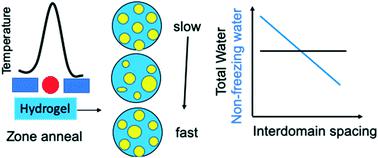当前位置:
X-MOL 学术
›
Mol. Syst. Des. Eng.
›
论文详情
Our official English website, www.x-mol.net, welcomes your feedback! (Note: you will need to create a separate account there.)
Kinetically controlled morphology in copolymer-based hydrogels crosslinked by crystalline nanodomains determines efficacy of ice inhibition
Molecular Systems Design & Engineering ( IF 3.6 ) Pub Date : 2019-09-24 , DOI: 10.1039/c9me00101h Pablo I. Sepulveda-Medina 1, 2, 3, 4 , Chao Wang 1, 2, 3, 4 , Ruipeng Li 4, 5, 6, 7 , Masafumi Fukuto 4, 5, 6, 7 , R. A. Weiss 1, 2, 3, 4 , Bryan D. Vogt 1, 2, 3, 4
Molecular Systems Design & Engineering ( IF 3.6 ) Pub Date : 2019-09-24 , DOI: 10.1039/c9me00101h Pablo I. Sepulveda-Medina 1, 2, 3, 4 , Chao Wang 1, 2, 3, 4 , Ruipeng Li 4, 5, 6, 7 , Masafumi Fukuto 4, 5, 6, 7 , R. A. Weiss 1, 2, 3, 4 , Bryan D. Vogt 1, 2, 3, 4
Affiliation

|
Nature uses protein structure to manipulate the properties of water by altering its local environment, but subtle changes in these structures can dramatically influence function. Here, a simple synthetic analog is demonstrated, a statistical copolymer of hydroxyethyl acrylate and n-octadecyl acrylate (HEA–ODA) with 21.3 mol% ODA, that generates a hydrogel in water. The crystallization of the ODA, whose nanodomains act as effective crosslinks, provides a simple route to manipulate the nanostructure through zone annealing without significantly altering the swelling ratio (1.38 to 1.22) of the hydrogel. Despite the identical average composition, changes in the nanostructure induced by zone annealing leads to significant differences in the inhibition of water crystallization within the hydrogels under supercooled conditions with the unfrozen water fraction varying between nearly 18 and 99%. Decreasing the average spacing between crystalline nanodomains leads to increased efficacy of the ice inhibition. However, the morphological details appear to be important as the average number of water molecules confined in a hypothetical square lattice based on the average interdomain spacing and average ODA nanodomain size does not appear to directly scale with the antifreeze capabilities. These results demonstrate control of water crystallization at supercooled temperatures within hydrogels without fluorinated hydrophobic moieties through manipulation of the nanostructure to confine the water.
中文翻译:

晶体纳米域交联的共聚物基水凝胶的动力学控制形态决定了抑冰功效
大自然利用蛋白质结构通过改变其局部环境来操纵水的性质,但是这些结构中的细微变化会极大地影响其功能。在这里,展示了一种简单的合成类似物,即丙烯酸羟乙酯与n的统计共聚物。具有21.3 mol%ODA的丙烯酸十八烷基酯(HEA–ODA),可在水中生成水凝胶。ODA的结晶(其纳米域充当有效的交联键)提供了一条简单的途径,可在不显着改变水凝胶的溶胀率(1.38至1.22)的情况下通过区域退火来操纵纳米结构。尽管平均组成相同,但由区域退火引起的纳米结构变化导致在过冷条件下水凝胶中水结晶抑制的显着差异,未冻结的水含量在18%至99%之间变化。减小晶体纳米域之间的平均间隔导致增加的冰抑制效力。然而,形态细节似乎很重要,因为基于平均域间间距和平均ODA纳米域大小,限制在假设的方格中的水分子平均数目似乎不会直接与防冻能力成比例。这些结果表明,通过操纵纳米结构来限制水,可以控制水凝胶中过冷温度下水的结晶,而没有氟化的疏水部分。
更新日期:2019-09-24
中文翻译:

晶体纳米域交联的共聚物基水凝胶的动力学控制形态决定了抑冰功效
大自然利用蛋白质结构通过改变其局部环境来操纵水的性质,但是这些结构中的细微变化会极大地影响其功能。在这里,展示了一种简单的合成类似物,即丙烯酸羟乙酯与n的统计共聚物。具有21.3 mol%ODA的丙烯酸十八烷基酯(HEA–ODA),可在水中生成水凝胶。ODA的结晶(其纳米域充当有效的交联键)提供了一条简单的途径,可在不显着改变水凝胶的溶胀率(1.38至1.22)的情况下通过区域退火来操纵纳米结构。尽管平均组成相同,但由区域退火引起的纳米结构变化导致在过冷条件下水凝胶中水结晶抑制的显着差异,未冻结的水含量在18%至99%之间变化。减小晶体纳米域之间的平均间隔导致增加的冰抑制效力。然而,形态细节似乎很重要,因为基于平均域间间距和平均ODA纳米域大小,限制在假设的方格中的水分子平均数目似乎不会直接与防冻能力成比例。这些结果表明,通过操纵纳米结构来限制水,可以控制水凝胶中过冷温度下水的结晶,而没有氟化的疏水部分。



























 京公网安备 11010802027423号
京公网安备 11010802027423号